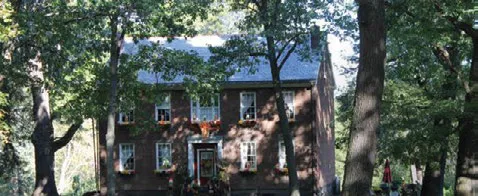Most of us are familiar with the story of Johnny Appleseed—the barefoot, bearded, coffee-sack-and-tin-pan-hat-wearing wanderer who traversed the American wilderness in the early 1800s, casting seeds and giving rise to umpteen apple trees across the Midwest. But did you know he spent some time here in good ol' Beaver County?
Jonathan Chapman, aka Johnny Appleseed, was born in Leominster, Mass., on September 26, 1774, just months before the onset of the Revolutionary War. His father, Nathaniel, fought as a minuteman at the Battle of Bunker (Breeds) Hill and later served in the Continental Army under Gen. George Washington. Chapman moved to Marietta, Ohio, at around the age of 20. It was around this time that the legend of Johnny Appleseed was sown.
Before setting out on his journeys into the frontier, Chapman would stock up on apple seeds, which he obtained cheaply from cider presses at local farms. One such farm was owned by the Littell family, which owned a large swath of land, including an apple orchard in Hanover Township, Beaver County.
William Littell was a Revolutionary War hero and early settler of Beaver County. Born in Belfast, Ireland, in 1740, Littell came to America while still a young man, marrying Elizabeth Walker, a native of Ireland. Together, they had nine children: Elizabeth, Jane, Mary, Alice, Agnes, James, William, David, and Thomas.During the Revolutionary War, Littell held a clerkship in the army and served as private secretary to Gen. Washington. After the war, he came to Beaver County and settled on a large piece of land in Hanover Township, where he built a small cabin. After he died in 1819, his son David inherited the land and built a much larger brick home.
Today, the David Littell House still sits along PA Route 18 near Mechanicsburg. (You may have seen it along your way to Burgettstown for a concert.) In 1986, this red brick Greek Revival house was listed as "JOHNNY APPLESEED IN BEAVER COUNTY" on the National Register of Historic Places. It is an excellent example of early nineteenth-century architecture.
It was here on the Littell homestead where Chapman (according to an article by LeMoyn Littell Parkinson in the April 17, 1957, issue of The Christian Science Monitor) would stay during the late summer to gather seeds:"He slept under a tree in good weather. When it rained, he stayed in a wagon shed. He washed his clothes in running water from a spring, wrung them out, and, climbing a tree, spread them out on long limbs. Asked why he did this, his reply was, 'To get them closer to the sun."
Chapman made many trips from this area out into the Midwest, sometimes following the Ohio River. At other times, he would land his canoe at Rochester and then follow the old Sandusky Trail (now known as Darlington Road) through Fallston, into East Palestine, Ohio, and beyond.
Today, Johnny Appleseed's legacy lives on, not just through the apples we enjoy, but also through countless fall festivals throughout the Midwest and Northwest, which honor his name. It's nice to know that this popular folk hero and legend of American culture played a part in the rich early history of Beaver County.Return to
